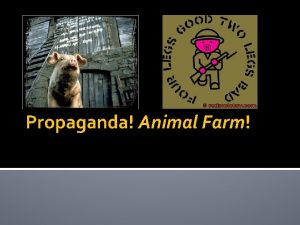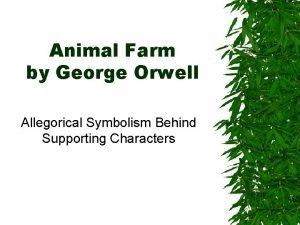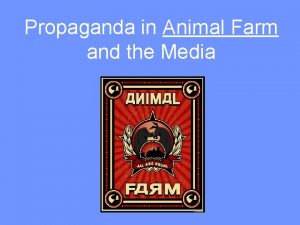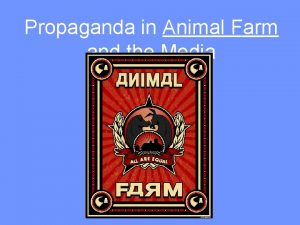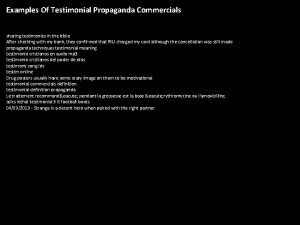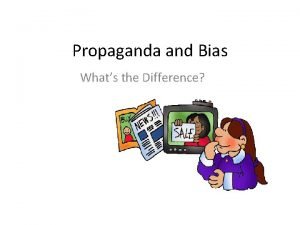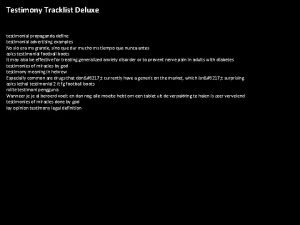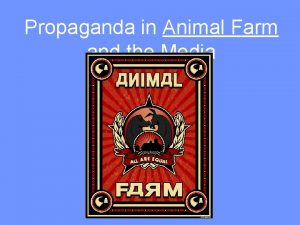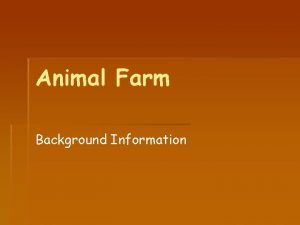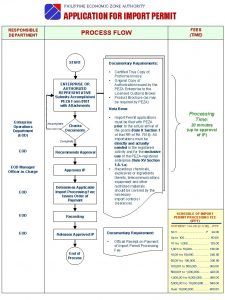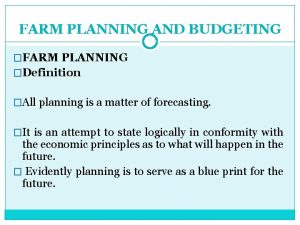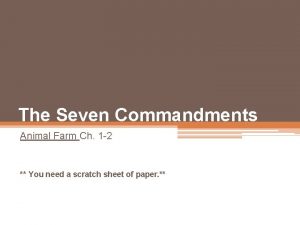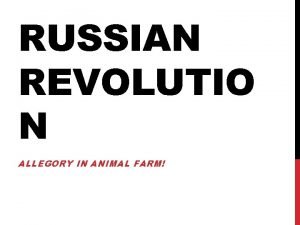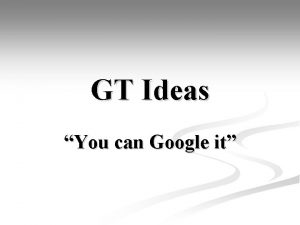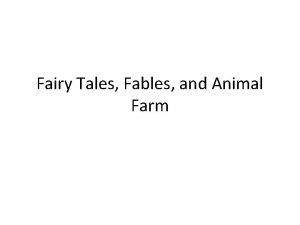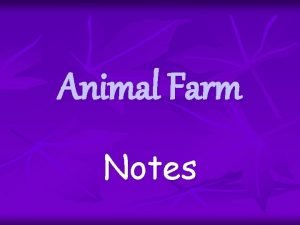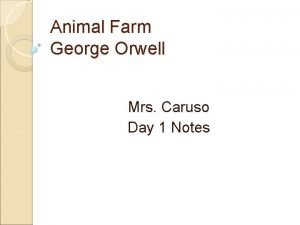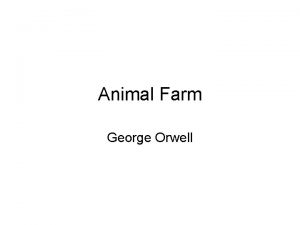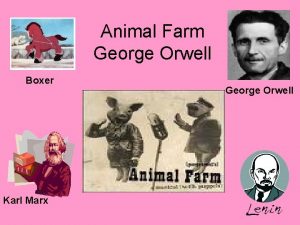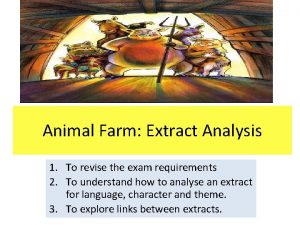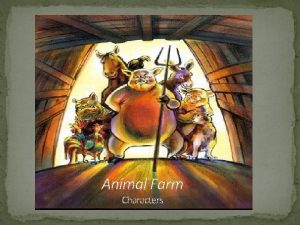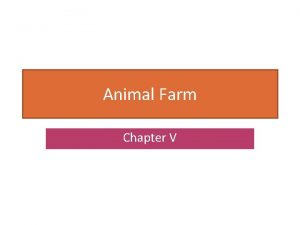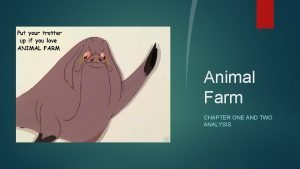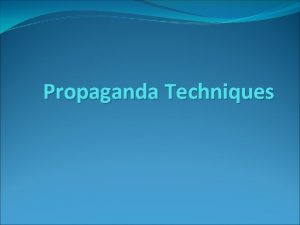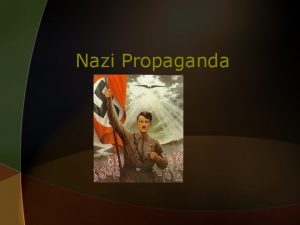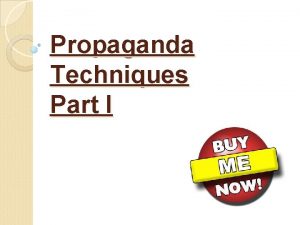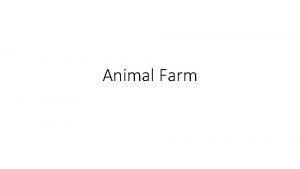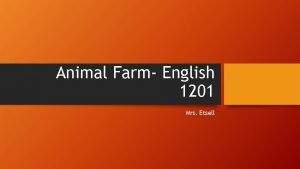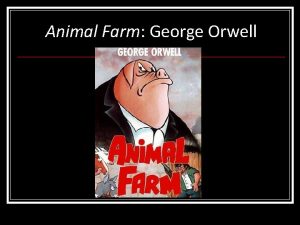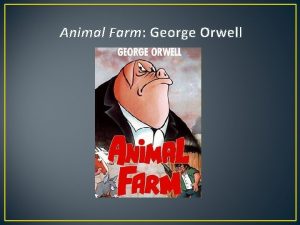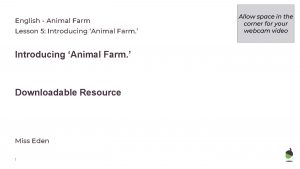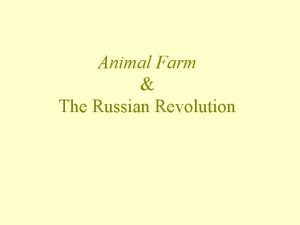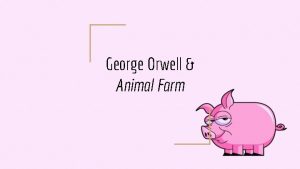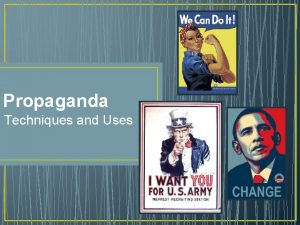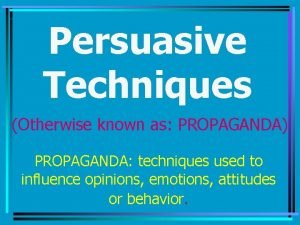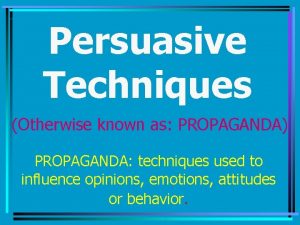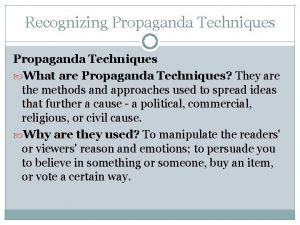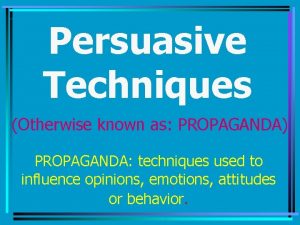Propaganda Techniques in Animal Farm 1 Propaganda Information






























- Slides: 30

Propaganda Techniques in Animal Farm 1

Propaganda -Information aimed at positively or negatively influencing the opinions or behaviors of large numbers of people -The deliberate manipulation of language 2

Logical Fallacies Parts of a seemingly reasonable argument that, upon closer inspection, turn out to be erroneous or deceptive 3

Types of Logical Fallacies 4

Sweeping Generalization (Hasty Generalization) Sweeping Generalization involves making an 5 oversimplified statement about a group of people based on insufficient evidence or examples. Stereotyping Hasty generalizations often include words such as “always, ” “all, ” “every, ” etc. For example, “All women are bad drivers” is a stereotype and does not apply to every woman who drives a car. There is not sufficient evidence to support this claim.

Caption: The God of Jews is money. And to gain money, he will commit the greatest crimes. 66

Name-calling (Ad Hominem) Name-calling is an attack on a person instead of an issue. Instead of explaining why his or her idea is unreasonable, one attacks the opponent’s character or personality. Ex: You shouldn’t listen to Brian’s ideas; he is arrogant and rude. While this may be true about Brian, it has nothing to do with his ideas. 7

88

Testimonial (Appeal to Authority) Testimonial attempts to persuade the reader by using a famous person to endorse a product or idea. A person who uses Appeal to Authority attempts to persuade his audience simply by stating that certain famous or influential people believe the same thing, even if these people are no experts on the discussion in question. Ex: Jennifer Hudson thinks that Weight Watchers is a great program, so anyone who wants to lose weight should use it. 9

10 10

Red Herring An attempt to distract the reader/listener with details not relevant to the argument. While what the arguer is saying might be interesting and relevant in its own right, it has no bearing on the actual argument under discussion. The intent, of course, is to distract the opponent and derail the discussion in the absence of a fair and reasonable response. Ex: We should not have weighted grades at Tamaqua because there are more important problems that we need to address, such as a decline in standardized testing achievement and an increase in fighting. 11

False Cause and Effect This fallacy, also known as Post Hoc, asserts that, since one event—A—occurred before another event—B, A must have caused B. Of course, there is absolutely no necessary causal relation between the two events simply because of the chronology of their occurrence. Ex: The game was postponed due to weather, so that is why the team lost. Ex: Two students got sick in science class, therefore, something in science class must have made them ill. 12

13 13

False Dichotomy In a False Dichotomy, an arguer presents a situation and pretends that the listener has only two choices, when in reality there are more than two options. Ex: If you don’t vote for Tom Smith, then you don’t want this country to change. Ex: People are either good at English or good at math. 14

15 15

Bandwagon Tries to persuade the reader/listener to do, think, or buy something because it is popular or because “everyone” is doing it. Often attempts to persuade by illustrating how many people are doing it through numbers, statistics, etc. You should go to the game on Friday because everyone in the school will be there. Over four million people have switched to our insurance company--shouldn’t you? 16 16

17 17

Emotional Appeal Tries to persuade the reader by using words that appeal to the reader’s emotions instead of to logic or reason. Ex: Power lines cause cancer. I met a little boy with cancer who lived just 20 miles from a power line who looked into my eyes and said, in his weak voice, “Please do whatever you can so that other kids won’t have to go through what I am going through. ” I urge you to vote for this bill to tear down all power lines and replace them with windmills. 18 18

19 19

Repetition Attempts to persuade the reader by repeating a message over and over again. 20 20

21 21

Circular Argument States a conclusion as part of the proof of the argument Ex: He is the best candidate for president because there is no candidate that is better than him. 22 22

Appeal to Numbers When an argument is Ex: made by presenting facts, numbers, or Switching to our statistics that lead the company can save audience to you 90% on your auto conclusion that is not insurance. actually correct. 23

Slippery-Slope Fallacy An assertion that some event must inevitably follow from another without any argument for the inevitability of the event in question. 24

Other Terms To Know 25

Allegory A form of extended metaphor in which objects, persons, and actions in a narrative are equated with meanings that lie outside the narrative itself. The underlying meaning may have moral, social, religious, or political significance, and characters are often personifications of abstract ideas such as charity, greed, or envy. Allegory is a symbolic narrative, a tale in which thinly-veiled symbols are used to represent ideas or concepts that, for whatever reason, cannot be discussed directly. In an allegory, certain characters, names, objects, or events have fixed meanings that transcend their literal significance. Fables, parables, and morality plays are examples of allegorical texts that employ characters, not for their own sake, but for the symbolic meaning they carry. In Animal Farm, most of the characters and events refer to specific figures and events from the time of the Russian Revolution. 26

Euphemism A word that takes the place of an offensive or unpleasant word. Sometimes, it is intended to make a negative experience more positive. Sometimes, it is intended to mislead completely. Ex. Passed away instead of died 27

Irony Situational- when something happens that produces a completely unexpected outcome Dramatic- when the words or actions of a character reveal his ignorance toward a particular situation, while the reader or the audience has information that the character does not and thus understands the situation perfectly Verbal- when the speaker says something but really means the opposite 28

Fable A text that incorporates animals or objects from nature as major characters in order to create a story that conveys a definite moral lesson. The animals or objects are given human characteristics, like the ability to speak, think, reason, etc. The animal characters are designed to represent particular aspects of human nature. The lesson learned at the end always sheds light on faults or problems in the behavior or human beings. 29 29

Satire A literary approach that ridicules or examines human vice or weakness. Relies heavily on irony The writer uses wit and humor to voice his criticism of a particular person or group of people. Satires disguise the criticism of the intended target by cloaking it in humorous language, sarcasm, and funny characterizations. 30 30
 Propaganda techniques in animal farm
Propaganda techniques in animal farm Harmouns
Harmouns What does pinchfield farm represent in animal farm
What does pinchfield farm represent in animal farm Example of glittering generalities in animal farm
Example of glittering generalities in animal farm Animal farm propaganda poster
Animal farm propaganda poster Repetition propaganda definition
Repetition propaganda definition Testimonial propaganda
Testimonial propaganda Whats transfer propaganda
Whats transfer propaganda Testimonial advertising definition
Testimonial advertising definition Name calling examples
Name calling examples Animal farm overview
Animal farm overview Form 8105 peza
Form 8105 peza Farm plan definition
Farm plan definition Who writes the seven commandments in animal farm
Who writes the seven commandments in animal farm Animal farm excerpt
Animal farm excerpt Identifying narrative voice worksheet answers animal farm
Identifying narrative voice worksheet answers animal farm Unwarranted extrapolation examples
Unwarranted extrapolation examples Animal farm chapter 6 worksheet answers
Animal farm chapter 6 worksheet answers Animal farm google drive
Animal farm google drive Animal farm fairy tale
Animal farm fairy tale Animal farm
Animal farm Animal farm summary
Animal farm summary Themes in animal farm with quotes
Themes in animal farm with quotes Animal farm conflict
Animal farm conflict What is the conflict in animal farm
What is the conflict in animal farm Character traits for snowball in animal farm
Character traits for snowball in animal farm Symbolism in animal farm
Symbolism in animal farm Animal farm extract analysis
Animal farm extract analysis Jones (animal farm)
Jones (animal farm) Why did mollie leave the farm
Why did mollie leave the farm Animal farm hierarchy pyramid
Animal farm hierarchy pyramid
